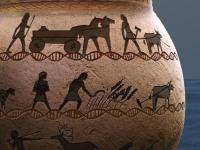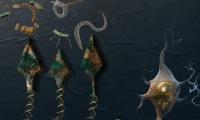MAP OF ANCESTORS AND DISEASE RISK

Lifestyle factors can have a major impact on the evolution of the human genome, by altering which genes are passed down to future generations; the effects of which can be seen many thousands of years later.
This is a key point in The Selection Landscape and Genetic Legacy of Ancient Eurasians, one of the four Nature articles based on analyses of ancient DNA from prehistoric human teeth and bones.
The article relies on ancient DNA data from 1,664 archaeological skeletons, ranging in age from the Mesolithic to the recent past, which was compared with DNA profiles from hundreds of thousands of present-day Europeans.
The prehistoric skeletal remains came from a region of Eurasia that extends from Lake Baikal in the east to the Atlantic Coast in the west, and from Scandinavia in the north to the Middle East in the south. Analyses of the ancient DNA yielded a number of remarkable discoveries.

Assistant Prof., Lundbeck Foundation GeoGenetics Centre, Globe Institute, University of Copenhagen, Denmark
‘One of the most striking results reported in The Selection Landscape and Genetic Legacy of Ancient Eurasians is that the lifestyles of the peoples in the Eurasian region over the last 10,000 years have resulted in a genetic legacy which impacts their present-day descendants, in terms of both their physical appearance and their risk of developing a number of diseases,’ says Evan Irving-Pease. As an Assistant Professor at The Globe Institute, University of Copenhagen, Irving-Pease’s specialist field is computational evolutionary biology, and he is the first author of The Selection Landscape.
One of the main challenges Dr. Irving-Pease and his co-authors sought to address was to trace the ancestral origins of each position in the DNA sequence of a present-day European. Dr. Irving-Pease explains that to achieve that, they first had to develop a new method of analysis:
‘If we model the genetic evolution that has taken place in Eurasia since the end of the Last Ice Age, from around 12,000 years ago up to the present, we find that four distinct populations contributed in different proportions to a typical present-day European genome: Eastern hunter-gatherers; Western hunter-gatherers; Caucasus hunter-gatherers; and Anatolian farmers,’ says Dr Irving-Pease.
‘And for each of these four groups, we looked at their genetic contribution to hundreds of thousands of positions in the genome which can be found in present-day Europeans. This was a very extensive mapping project involving a large team of researchers from around the world,’ continues Dr. Irving-Pease.
MILK, FATTY ACIDS AND TYPE 2 DIABETES
One of the discoveries made by the researchers concerns the development of adult lactose tolerance – the ability to digest the milk sugar found in dairy products into adulthood. Here, the ancient bones reveal that adult lactose tolerance emerged in Europe around 6,000 years ago, about 1,000 years before the arrival of the Yamnaya, who reared cattle and sheep, and left a significant genetic legacy in Northwestern Europe: a legacy which has prevailed to this day in much of this region. Intriguingly, the researchers also discovered evidence that natural selection has been acting on this region of the genome for many thousands of years before the emergence of adult lactose tolerance.
Another nutritional advantage, the ability to convert short-chain fatty acids into long-chain fatty acids, improving survival on a vegetable-rich diet, also has a different evolutionary history in Europe than previously assumed. The Selection Landscape reveals that the migrants who reached Europe during the Neolithic had already acquired this genetic advantage by the time they arrived.

The analyses further reveal widespread selection acting in regions of the genome responsible for immunity. The article proposes that this may be connected with an increased Bronze Age prevalence of pathogenic microorganisms, which in turn is believed to partly account for the very high prevalence today of autoimmune disorders.
The Selection Landscape deals with genetic risk variants associated with a number of other diseases, and also with the genetic aspects of physiological traits determining appearance and physique, and how these are determined by the DNA legacy left by the different waves of migration.
As for disease risk, the study indicates that a number of present-day diseases are influenced by how much DNA the individual carries from the two major migrations of populations that took place in the Eurasian region after the Last Ice Age.
For example, individuals with a high proportion of DNA from ancient farmers, which is more common in Southern Europe, are more likely to carry genes linked to mood disorders, while in Eastern Europe, which has a high presence of hunter-gatherer DNA, there will, for example, be an increased genetic risk of developing Type 2 diabetes and Alzheimer’s disease.
William Barrie, evolutionary biologist and a postdoc at the University of Cambridge, is an expert in computational analysis of ancient DNA. Dr. Barrie is one of the co-authors of The Selection Landscape, where part of his role was to look for ApoE4 in the ancient DNA.
ApoE4 is a genetic risk variant that significantly increases risk for Alzheimer’s disease, and Dr. Barrie and colleagues found that ApoE4 within Eurasia is most strongly found in modern DNA which derives from the early hunter-gatherer populations which inhabited prehistoric Europe.
‘DNA from hunter-gatherers is present at higher levels in Northeastern Europe, which means the region has an elevated genetic risk of developing Alzheimer’s disease,’ Dr. Barrie explains.
Going forward, analyses of the ancient bones may also be able to provide new insights into the evolutionary history of mental health disorders, explains Dr. Barrie, adding that:
‘This would make a lot of sense in relation to schizophrenia, for example, as schizophrenia has been widely researched through genome-wide association studies (GWAS), so the basis for tracing this disorder back in time exists.’
When it comes to traits of appearance and physique in present-day individuals in the Eurasian region, the analyses demonstrate that the Yamnaya were genetically predisposed to tall stature. This is one of the reasons why Northwestern Europeans today are typically taller than Southern Europeans. Along with the farmer populations, the Yamnaya were also lighter-skinned than the hunter-gatherer groups.
The Selection Landscape also reveals that the gene pool of all contemporary European populations contains a mixture with variable proportions of DNA inherited from the different migration waves within Eurasia during and after the Last Ice Age.
Therefore, the greatest genetic impact from Western hunter-gatherers is found today in the Baltics, Belarus, Poland and Russia. Whereas the traces of the farmers from Anatolia, who in the Neolithic spread into the rest of Europe, are best represented today in Southern Europe.

Part of the theme